Honda unlocks more power from the 2016 CRF250R and makes it a serious contender for 250cc supremacy.
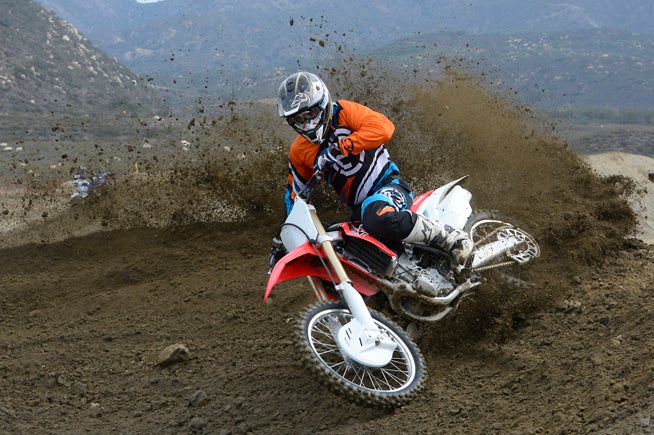
Honda probably got tired of hearing it right after they introduced the 2015 CRF250R…
“What? You didn’t pull any more power out of the engine? You say you just focused on improving its character? Well, great. But no more power? Not one pony? Zero? Zip? Nada?”
Which wouldn’t have been an issue if the CRF250R was already the most powerful bike in a class where squeezing every last bit of juice out of a given motor is paramount to success. Unlike the two-stroke era, it’s pretty rare these days when the 250 quadra-stroker that makes the most shear power fails to win a given shootout—if it doesn’t, then there was something else seriously wrong with it in the first place.
And that was the rub with the CRF250R in 2015. Quick? Yes. Great-handling? Natch. Innovative? Only the best onboard engine map adjusting system in the class. Great suspension? Yessirree. Fastest in the class? (Que the buzzer and announce the lovely parting gift here)
The good news is that Honda was apparently well aware of the fact even though it does deserve some credit for making some solid improvements to the 2015 CRF even after redesigning the bike completely in 2014. However, in a class that has been where the difference between winning and losing can often be seen on the dyno, the Honda still needed more motor. For 2016, the CRF250R gets it, and we think it may be able to hold its own with the top power brokers in the class.
This discovery came to us when Honda invited us to Pala Raceway near San Diego, California, to spin some laps on the 2016 CRF250R. From the moment we arrived, we knew that Pala’s flowing layout would expose any weakness in the CRF’s punching power, something that Honda claimed to have fixed. After spending the day aboard the revised 2016 Honda CRF250R, we believe them.
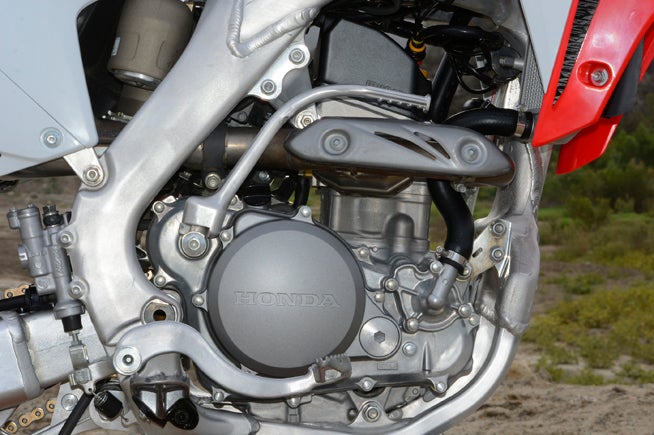
Take a quick look and the 2016 CRF250R’s liquid-cooled, fuel-injected, Unicam SOHC single-cylinder motor doesn’t appear to be any different than the 2015’s. Its oversquare 76.8mm x 53.8mm bore and stroke is the same as before, and its Dual-Timing PGM-FI, 46mm throttle body size is the same, as is Honda’s brilliant Engine Mode Select Button engine mapping feature that was introduced last year. It’s a feature that allows the rider to change among three preset engine maps to alter the CRF’s performance character on the track rather than in the pits—more on that later.
 But take another look and you’ll notice a funny looking little bubble in the header pipe behind the heat shield? A heat bubble that occurred during the forming of the pipe, perhaps? Nope. FMF pipe? Er, no, but the idea is the same. The 2016 CRF boasts a redesigned exhaust system that now features a torque-boosting resonator chamber tucked behind the heat shield. Honda also refined the muffler cores, making their i.d. slightly larger to reduce exhaust back pressure and thereby increase flow. On the intake side, Honda engineers also revised the air intake boot, which effectively shortens the overall intake tract to foster stronger top-end power.
But take another look and you’ll notice a funny looking little bubble in the header pipe behind the heat shield? A heat bubble that occurred during the forming of the pipe, perhaps? Nope. FMF pipe? Er, no, but the idea is the same. The 2016 CRF boasts a redesigned exhaust system that now features a torque-boosting resonator chamber tucked behind the heat shield. Honda also refined the muffler cores, making their i.d. slightly larger to reduce exhaust back pressure and thereby increase flow. On the intake side, Honda engineers also revised the air intake boot, which effectively shortens the overall intake tract to foster stronger top-end power.
But you have to get inside the engine to see the other power-enhancing differences Honda made to the CRF250F for 2016. They include a new piston and connecting rod that shave 34 grams of reciprocating weight—most of it from the piston—to help the engine rev higher and quicker, offsetting the bump in compression ratio from 13.5:1 to 13.8:1; higher compression typically increases power but at the expense of rpm potential. Honda also lightened the valve train to free up even more revs by replacing the previous model’s steel exhaust valves with titanium valves. Both the intake and exhaust ports have also been reshaped to increase flow, and the 2016 CRF250R gets a new camshaft that increases valve lift for better high-rpm breathing. New valve springs are also employed to better control valve motion with the more aggressive cam. The only other corresponding change Honda made was to make the CRF250R’s left-side radiator slightly larger to increase cooling capacity and better dissipate the additional heat generated by the performance-enhancing engine changes.
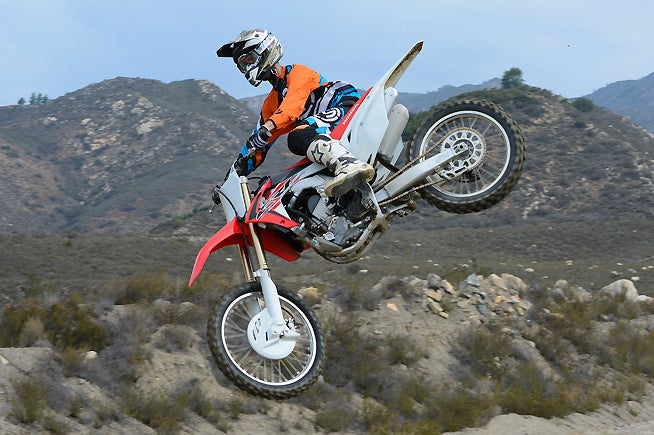
The payoff of these changes is a Honda engine that retains its general smoothness and crisp response while packing a lot more snap throughout the rev range. Last year, we complained about the CRF’s relative lack of brawn, but we have no such issues with it this year. Whether it was a vet tester or studly off-road/moto ace Ryan Abbatoye, we felt that the new engine rips cleanly off the bottom, continues to pull hard through the midrange and revs out with a lot more authority up top than the 2015 engine. This newfound power reduces the need to row the CRF250R’s shift lever in order to maintain momentum. Need to grunt out of a slow corner? The Honda has enough oomph to get you going. Want to hold that gear and let the motor rev to clear the next tabletop? There’s plenty of thrust to make the obstacle disappear beneath you, and there’s no more need to keep the throttle cracked upon landing in order to maintain momentum for the next jump either. The Honda’s engine is so much fun it left us grinning under our chinbars. Now it has the bite to match its bark, and it as actually even easier to ride than last year’s machine.
One thing that we found particularly interesting is how the CRF250R’s improved power output altered our tastes when it came time the ideal Engine Mode Select map for our varied riding styles. A year ago, the CRF’s lack of punch left our slower testers seeking the more aggressive Mode 3, feeling the need for a more aggressive hit, while superhero Abbatoye preferred Mode 1 because he wanted more low-end beef to catapult him up and over moonshot jumps. But with the Honda’s more robust engine order in the universe has been restored. The CRF’s more prodigious thrust left our vets happy with the stock default Mode 1, knowing that the engine wouldn’t sign off so readily at higher rpm, leaving plenty of power on tap throughout the rev range. Meanwhile, Abbatoye preferred the most aggressive Map 3 because he found that it didn’t sacrifice nearly as much low-end torque as before, allowing him to tap into the CRF’s more aggressive midrange/top-end power and jump into hyperspace.
Even cooler than that, however, is that the Engine Mode Select feature allows for totally custom maps in Modes 2 and 3, and Honda came up with more useable map settings for the least aggressive Mode 2, which felt as if it really leveled the power curve and found favor among some of our crew. The only bummer is that Honda has yet to come up with a convenient handheld device, such as the units offered by Kawasaki and Yamaha, to make mapping changes, so you’ll still have to drag your laptop to the track in order to load new maps. We hear that Honda intends to remedy this situation very soon, although we couldn’t get any Honda officials to confirm that.
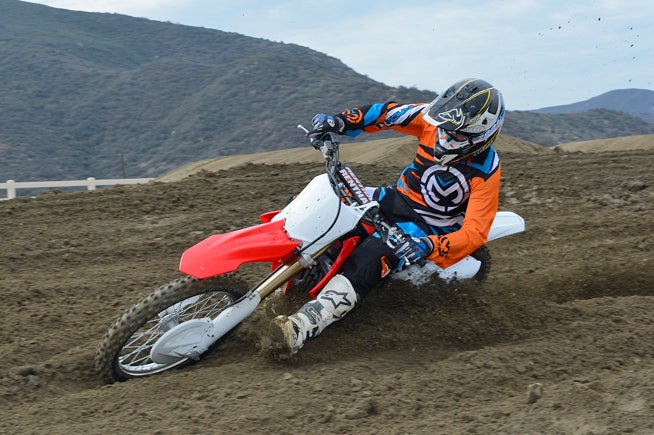
The 2016 CRF250R’s chassis is the same as last year’s, complete with the redesigned subframe that was created to help save weight and improve the ergos. The light-steering CR can hunker down and track through ruts without any issues.
Like we said, the CRF250R’s happier engine means that you won’t be shifting as often, but Honda went ahead and made changes to its already butter-smooth five-speed gearbox, too. It’s a subtle update, but it’s in there: The 2016 model gets a new shift drum stopper with a bearing added to the roller in order to improve shifting feel under a load. We’re sure that’s going to be important to someone, but when you are already recognized for having among the best clutch and transmission action in the class, it seems superfluous to us. Then again, we aren’t full-blown factory stars who mercilessly pound through the gears with clutch-less upshifts and downshifts for 30-minute motos, so perhaps there is a reliability angle to consider as well.
The CRF250R has been recognized as a great-handling machine since its redesign (and before it), and its chassis specs are identical to last year’s machine for good reason. Its narrow, aluminum perimeter frame boasts a low center of gravity really that allows the rider to carve a berm or rail through a rutted corner with ease. Honda has stayed with the same 58.6-inch wheelbase, 27 degrees of rake and 4.6 inches of trail since the redesign, as the combination yields a machine that steers precisely and with minimal effort, the forté of the design. To aid high-speed stability the CRF250R’s also equipped with a Honda Progressive Steering Damper (HPSD). The compact mechanical unit is attached to the lower triple clamp, and it can be adjusted to increase resistance to steering deflection as needed.
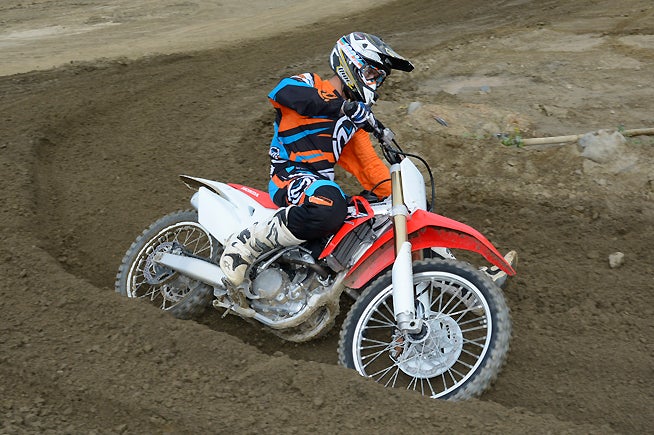
Even so, now that the CRF250R is faster than before, Abbatoye noticed a tendency for our test machine to twitch in the ruts during high-speed braking. Fortunately, this little handling quirk was easily fixed thanks to one of the many changes that Honda made to the 2016 CRF250R’s 49mm Showa (SFF TAC) air fork. The latest version still boasts the same 12.2 inches of travel as before, but the outer legs are now 5mm longer, like the 2016 CRF450R’s fork legs. However, unlike the 450, Honda has set the fork legs to protrude 5mm above the top of the 250’s clamp rather than flush with it, thus giving the rider another way to tune the CRF’s handling character. Lowering the fork legs in the clamp (so that ends of the legs are flush) greatly changes improves the 250R’s resistance to braking bump forces through the bars for fast riders. For most riders who might be seeking a little more stability, we would recommend starting with a 2.5mm change in the same direction to see if it gets the job done for you without noticeably affecting the Honda’s amazingly light steering effort.
Honda also attempted to improve the overall fork action of the SFF TAC. As before, the air chambers are incorporated in the left leg, while the right leg houses the damping cartridge, but unlike other Showa air fork designs used by its competition, the CRF250R houses all three air chambers (Inner Chamber, Outer Chamber, Balance Chamber) inside the fork, same as the factory Showa fork, to reduce the chance of impact damage to an external Balance Chamber.
Compared to the 2015 CRF250R, pressure in the Inner Chamber (primary spring) has been reduced in attempt to provide more suppleness in initial travel. Honda also redesigned the inner fork seal by changing the shape and going from two seals to three seals. Honda claims that the new design decreases friction. A third adjustment valve has also been added so that the Outer Chamber pressure can be increased to resist bottoming. The Outer Chamber pressure was not adjustable in 2015. Honda also made slight valving adjustments to the fork cartridge to compensate for the reduced friction of the new seals.
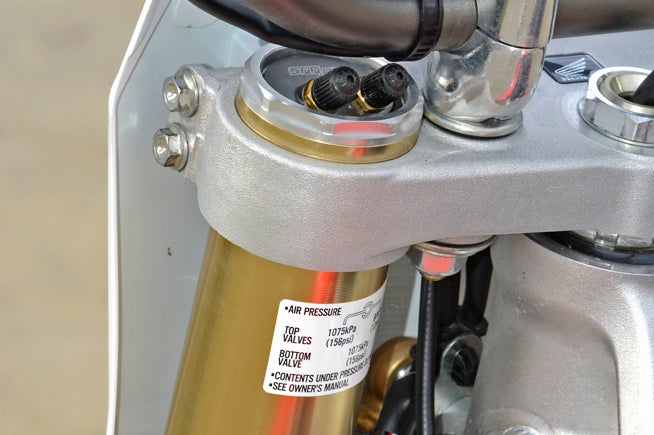
While Honda still recommends that riders attempt to tune the SFF TAC through valving rather than messing with air-chamber pressure, which alters the spring rate, our testers noticed that the stock settings, we found it easier to dial-in our fork by making air pressure changes first, as Abbatoye felt that the fork action was too stiff initially, even on what was a mostly smooth surface at Pala. Showa engineers remedied this by reducing the Outer Pressure chamber from 12 psi to 8 psi and increasing the Balance Chamber pressure from 154 psi to 160 psi on our test bike. The difference was night and day, as the fork now delivered a supple ride through stutter bumps while refusing to bottom during landings from big jumps. After that, it was just a matter of twisting the damping clickers, same as a conventional spring fork, to find our preferred settings. One other positive change Honda made for 2016 was to increase the number of clicks per rotation from four to eight, doubling the number of incremental adjustments that can be made. We appreciate that, as we tended to notice that the 2015 fork was either dead-on or way off when going from one click to the next.
Like the fork, the CRF250R’s Showa piggyback reservoir single-shock has received minor valving changes for 2016 to keep the rear suspension action in balance with the fork action, and it, too, gets double the amount of clicker adjustments to effect more minute damping changes. Otherwise, the rest of Honda’s Pro-Link rear suspension is unchanged from last year, when the shock received a stiffer and lighter spring. The shock still offers rebound adjustment, along with low-speed compression adjustment and high-speed compression damping adjustment.
But even after all the changes that Honda has made to the CRF250R over the past 2 years to bring it to its current level of competitiveness, there’ still one thing that we absolutely hate about it. The Honda still has a nice and compact ergonomic layout from the rear of the seat into the sides of the tank, yet its overall ergonomic comfort is seriously spoiled by a radiator shroud/louver design that snags the riders knee and/or boot every time he or she throws a leg forward to dive into a corner. To call it annoying would be an understatement, although we do realize that hate is a strong word—that’s why we used it. Shame, too, because Honda’s move to slim up the subframe in 2014 was a positive change. We would just invite ‘em to finish the job at the front of the bike now. Perhaps moving to smaller or narrower, V-shaped radiators and completely redesigning the shrouds, like some of its competitors have, might do the trick…hint, hint… Until then, the CRF250R is an otherwise great bike that suffers with a serious rider comfort flaw.
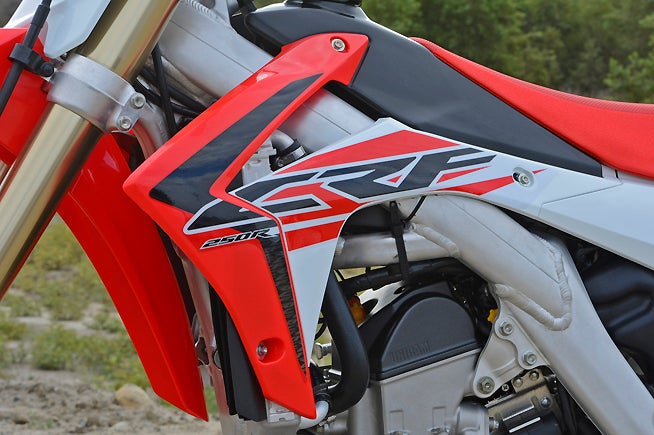
There are a two other minor changes worth noting on the 2016 CRF250R. They include a revised footpeg bracket design that is supposed to be less likely to collect crud when the going gets muddy. Also, Honda apparently shares Yamaha’s “smaller is better” line of reasoning where it pertains to the diameter of the chain roller. Honda has reduced the size of the 250’s chain roller from 38mm to 34mm to allow for more swingarm travel before the chain roller contacts the chain, which could potentially cause some chain torque-induced traction loss at the rear wheel. As the old saying goes, what will they think up next?
We are totally cool with the power and feel of the CRF250R’s 260mm front wave rotor and Nissin two-piston caliper. In fact, front and rear, the brakes are neither grabby nor wooden feeling, just smooth and powerful. When it comes to grab, however, we do appreciate that the CRF250R is equipped with Dunlop’s Geomax MX52 tires. About the only thing that could be better would be if it came with the MX32s, but only because we know just how damn good those tires are. The MX52s offer more than acceptable grip but with way more wear resistance than the suction cup-like MX32s.
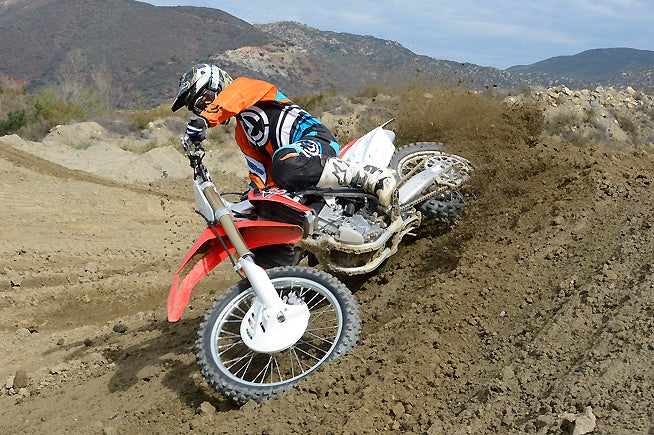
Despite our gripes about its ergos, we have to admit that we would have been neither surprised nor disappointing if Honda had raised the price of the 2016 CRF250R commensurate to its level of improvement. After all, its engine is now legitimately potent, its latest-gen SFF TAC fork delivers more adjustability—for handling as well as suspension compliance—and its chassis is still a thing of beauty. So, if the 2016 CRF250R’s MSRP had been $200-300 higher, we would have understood.
But that’s where the customer wins big time, because the 2016 CRF250R’s $7599 price tag is identical to that of the 2015, and the ’16 is a much faster motorcycle. There’s no question that Honda has whipped the CRF250R into class contender shape. Is the CRF250R the fastest bike in the 250cc class for 2016? We can honestly say we don’t know yet. That’s something we couldn’t say last year because we knew the answer even before we finished riding the other 250s, and that bodes well for Honda.
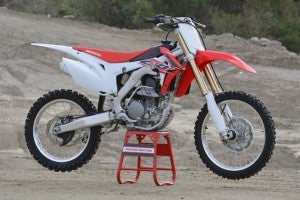 2016 Honda CRF250R Specifications
2016 Honda CRF250R Specifications
MSRP: $7599
Engine Type: 249cc liquid-cooled single-cylinder four-stroke
Bore and Stroke: 76.8mm x 53.8mm
Compression Ratio: 13.8:1
Valve Train: Unicam®, four-valve; 30.5mm intake, titanium; 25mm exhaust, titanium
Induction: Dual-Timing PGM-FI, 46mm throttle body
Ignition: Full transistor with electronic advance
Transmission: Close-ratio five-speed
Final Drive: #520 chain; 13T/49T
Suspension
Front: 49mm inverted Showa SFF-Air fork with 30-position rebound and 30-position compression damping adjustability; 12.2 inches travel
Rear: Pro-Link Showa single shock with adjustable spring preload, 34-position rebound damping adjustability, and compression damping adjustment separated into low-speed (26 positions) and high-speed (3.5 turns); 12.3 inches travel
Brakes
Front: Single 260mm wave-style disc with twin-piston caliper
Rear: Single 240mm wave-style disc
Tires
Front: Dunlop MX52 80/100-21
Rear: Dunlop MX52 100/90-19
Wheelbase: 58.6 inches
Rake: 27° 23’
Trail: 118mm (4.6 inches)
Seat Height: 37.4 inches
Ground Clearance: 12.7 inches
Fuel Capacity: 1.7 gallons
Color: Red
Claimed Curb Weight*: 231.0 pounds
*Includes all standard equipment, required fluids and full tank of fuel—ready to ride.
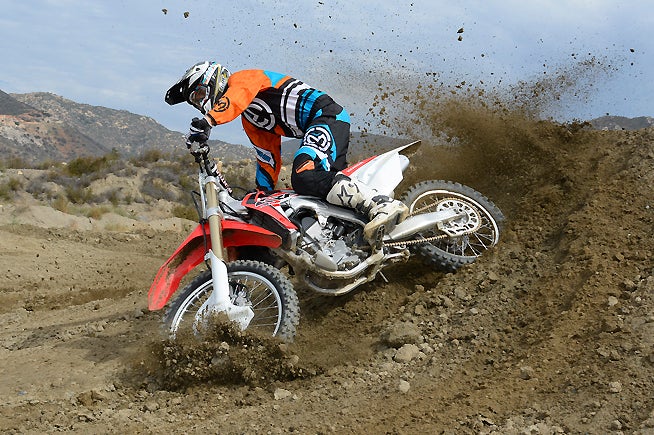
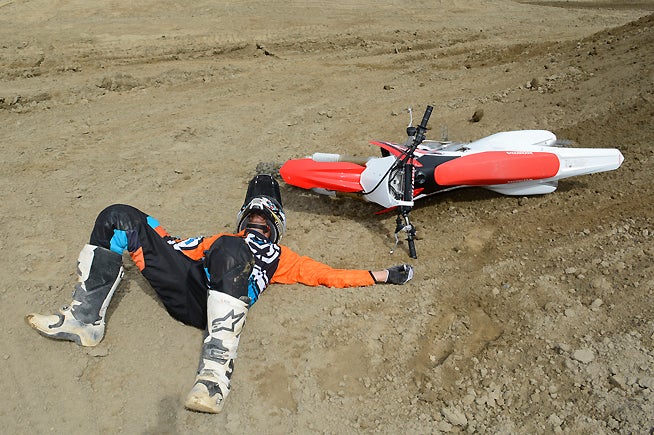
 Your Privacy Choices
Your Privacy Choices